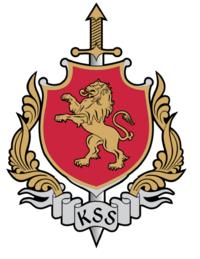Brat's War
| Brat’s War | |||
|---|---|---|---|
| Student uprisings of 2004 in Salikhia | |||
 (clockwise from top)
| |||
| Date | 30 August 2004 - 22 September 2004 | ||
| Location | |||
| Caused by | Increased university and school fees, use of corporal punishment, heavy 12-hour workloads in secondary schools, repression of student movements and banning of student associations. | ||
| Goals | Establishment of a public and secular education system, prohibition of physical punishment, abolition of legislation prohibiting student associations, etc. | ||
| Methods | Demonstration, rioting, looting, assault, shooting, arson, seizure of school buildings, armed confrontation | ||
| Resulted in | Uprising failure
| ||
| Parties to the civil conflict | |||
| |||
| Lead figures | |||
| Number | |||
| |||
| Casualties | |||
| |||
| |||
Trigger
Development
KSS
The KSS (National Secretariat of Commandos), commonly known as "the fumigators", was created on an experimental basis in the mid-1990s, but its first major appearance was at this event. Consisting mainly of small paramilitary squads, they were dedicated to the kidnapping, torture, interrogation, rape, murder and disappearance of political opponents, guerrillas, intellectuals, students suspected of collaboration and their families and contacts, as well as the running of clandestine detention centres.
The KSS units were made up of both regular and rotating personnel, including military personnel of all ranks, from privates to senior officers such as Angeloz Kakhatiani, commander of the Salikhia Air Force and head of the agency.
The KSS at the time was directly dependent on the forces in which they were based, and this was not necessarily where they were based. The squadron members had the prerogative over the property of the victims, being able to appropriate both their movable and immovable property as spoils of war.
To guarantee impunity and the non-intervention of "legal" security forces (such as the police), they requested a permit known as "green light". Thus, if a family member, neighbour or building manager contacted the nearest police station, they were given a message along the lines of "we are aware of what you have described, but we cannot act at the moment". This institution was responsible for a large part of the almost 13,000 dissidents who disappeared during the uprising, many of whom are still unaccounted for to this day.

